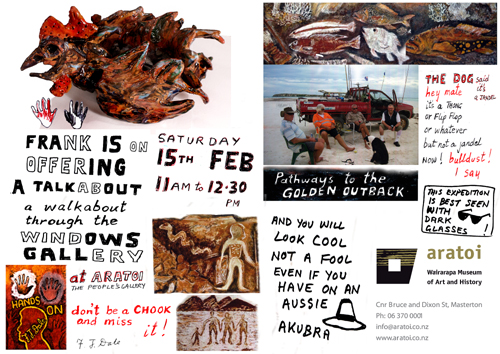Frank Dale found a type of spiritual home a long way from Wairarapa, where he was once a teacher and keen cricketer - in the Western Australian outback, some 450 km north of Perth.
He travelled there to recover after two health scares in 2012 and 2013: “Part of my recovery plan was to explore new territories, go walkabout, gold prospecting and also to paint,” he says. Frank travelled inland and, fittingly, followed the unsealed pathways into the outback that are named ‘roads to recovery’, as detouring from them can be fatal.
He calls the resulting exhibition of artwork and illustrated notes a ‘hands on’ project, chiefly because he looked to the desert for his raw materials: he collected earth and ground it up with a mortar and pestle – often in the back of his car – then used glue to bind it together to make the red, ochre, white and green pigments for his paintings. “My car served as my studio, campervan, kitchen, and storage cupboard…A very small footprint in a vast space,” he says.
By using homegrown, home-ground paints, Frank was connecting with an ancient tradition stretching back some 800,000 years to Aboriginal examples that can still be seen today, and to ancient cave art found in Europe. He was conscious that red ochre was considered sacred and revered as blood by Aboriginals. Closer to home we have drawings done by Maori using charcoal from their fires, and red ochre (haematite / kōkōwai) in caves at Weka Pass, north Canterbury, estimated to be between 600 and 100 years old.
He worked on many of his drawings and paintings on the spot, such as his painting of the old Post Office building at Mt Magnet, which saw the asphalt getting “sticky” in the heat, and Aboriginal children gathering round to see the work take shape.
Along the way he met people who became friends and fellow adventurers, and encountered stories and history that inspired him, such as that of Daisy Bates (1859-1951). Daisy made a lifelong study of Australia’s native people, advocated for them and became the country’s best known anthropologist and a major collector of Aboriginal objects.
She is depicted in one of Frank’s paintings in her signature Edwardian attire, which she wore even in the outback, observing an Aboriginal man painting the interior of his cave in the eons-old way by blowing pigment onto his hand placed against the wall. Frank was also impressed with the story of Monsignor John Hawes who labored for seven years to construct the Church of Our Lady in Mullewa, depicted in another painting. He went on to build numerous other churches acting variously as architect, stone mason, carpenter and moulder.
Frank, who grew up in the former Rhodesia, says he comes from a family steeped in art. He was encouraged to take up art himself when three of his works were placed in three different art competitions around 10 years ago.
The exhibition is accompanied by a booklet charting his journey, and how he arrived at his paintings, through jottings, sketches and working drawings. This adds another dimension to the show that as a whole shows a man brimming with ideas and the buzz of exploring a unique environment and its people. The outback has clearly had a lasting impact.
Frank will give a talk about his work at Aratoi on Sat 15 Feb, 11am-12.30pm.

On show at Aratoi: Hands On – Pathways to the Golden Outback by Frank Dale, until 2 March; Close to Home: William Beetham Portraits, until 23 Feb; Apocalpse now: Anthony Davies, until 23 Feb; Reflection and Image – Recent works by Bridget Bidwill & Andree de Latour, until 23 Feb; Vincent Ward Breath – the fleeting intensity of life, until 28 Feb.
nsity of life, until 28 Feb.